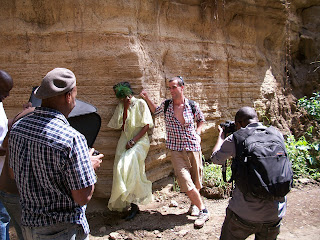I spent my last few days in Kenya playing catch up. In more ways than one, I feel like I didn’t accomplish what I wanted to in the 9 weeks on the ground that actually felt more like 9 days. I knew going in that the task at hand was overwhelming but I had hoped to carve out a piece that I could really influence. Don’t get me wrong, I know I helped the businesses out but I had much higher hopes and loftier goals than what I actually completed. I found myself wanting to spend time trying to making a difference, or more accurately as I think about it now sitting on a plane somewhere over the Atlantic on my way home, I needed to feel that I was making a difference. It is a strange feeling. I know I helped but I didn’t get that self actualizing feeling that I helped someone. Which is not the reason why I went there in the first place. I think it comes down to the fact that during my time in Africa, Kenya became home. I got up, went to work 5 days a week and had fun on the weekends. What I was doing there didn’t feel different than any other job. And when I was getting ready to leave, I saw how much help was really needed from an outsider’s perspective.
So in my last few days I spent time with the street kids, the orphaned and abandoned children’s center in the hospital and seeing where else I could lend a hand. I said my goodbyes and promised if I was ever back in their neck of the woods, I’d stop in. I was careful not to make promises I didn’t fully intend on keeping. I really can’t put into words how it felt driving out of Eldoret. On the way to the airport, Ryan and I asked the driver to take us through the slums on the outskirts of town where many of the folks I worked with at Imani and Watalamu lived. It was depressing on two levels. First, the sheer size and scope of the poverty stricken slum was overwhelming. It was busier than the downtown area with significantly less infrastructure. Secondly, I felt horrible that it took me until my last hours in town to truly understand what kind of hand in life everyone who lived there was dealt. The impact of that 10 minutes drive was as significant as any of the other experiences I had.
We finally got to the airport and I sat in front of a TV for the first time since I landed in Kenya. Glad to see that Sundays will have meaning this fall. Sad to see Boehner and Obama can’t work together, reminds me of Kenyan politics with all the posturing and feather flexing. Ryan and I sat in the waiting area almost in disbelief that our time in Kenya was over. We stepped on the plane with a beautiful sunset covering Eldoret. Picturesque way to end the trip of a lifetime.
I have had plenty of time to reflect on the experience during the 28+ hours of travel thus far. I was somewhat overwhelmed when I walked into the main terminal at Heathrow. After 2.5 months in Eldoret; the simple shops, street vendors, little to no marketing…….Tiffany’s, Coach, the bright white lights, 30 choices of water, 40 types of soda and the smell of Starbucks all within 2 seconds made me take a step back. I gathered myself and eventually found my way to a breakfast place for a bacon and egg bagel which tasted like heaven. I used my credit card for the first time in nearly 3 months. Heathrow was the first taste of what it will be like to be back home. Meals don’t cost $0.40, I can drink tap water, I won’t be the only white person within 5 blocks, hopefully put back on at least a few of the 12 pounds I lost, …plenty of things will change. Most importantly, I know the time I spent in Eldoret will change how I look at things. How I view the “third world”. How I approach business decisions, and my feelings toward the role of business in socioeconomic development.
I know I’ll miss Kenya and it will be strange to wake up tomorrow and not be at IU House. But it’s time for me to come home. I have tons of stuff coming up, Tony’s wedding, trip to Indian Lake, moving to Grand Rapids and starting the next phase of my career with a great company in Herman Miller. Thanks to everyone for the e-mails, comments and well wishes. Thanks to my mom and dad for supporting me regardless how crazy my choices of adventures makes them. I can’t begin to tell you how lucky and blessed I feel to have such great friends and family and to live in the greatest country in the world. It’s been real Kenya, but it’s time for the next chapter. Tutuonana baadaye
 |
| One of my favorite pictures from the entire trip. Maasai Warriors dancing |
PS. I’m done blogging. Its too much work and my life in the US isn’t that cool.




























